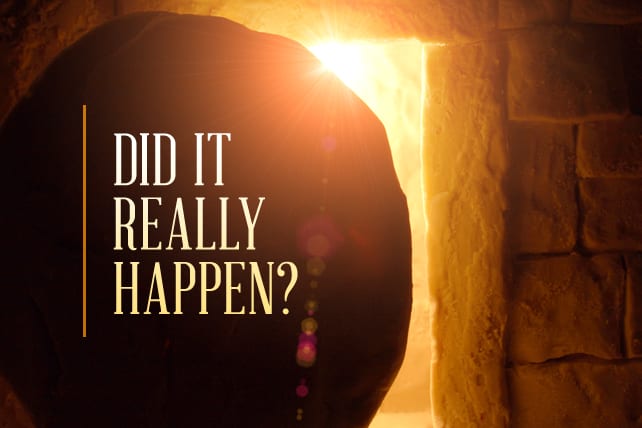This may be a no-brainer for some youth workers, but I always found it helpful talking about the insane importance of the Resurrection during the Easter season. Personally, I don’t think any youth pastor can get bored talking about the Resurrection.
In youth group weeks leading up to Easter Sunday, I would talk about:
– why the Resurrection is so central to the Christian faith
– how the Resurrection sent a shockwave in and through history
– the fact that the Resurrection really happened
Some of my (more) skeptical students would challenge with “rumors” that claimed the Resurrection was not REAL. So I decided to compile four of the “most common rumors” students heard about the Resurrection of Jesus.
Four Rumors Skeptical Students Need to Put to Rest:
(4) The story of Jesus’ Resurrection is a lie.
One must understand something about history, especially in the context of first century Jewish oral tradition. Many times, the historical records of certain major events like the Persian wars or the movement of Alexander the Great were given to us by only one source and it took a while to record it. Even though we have so few sources that were written a long time after the event, no one really doubts the truth claims made in the historical documents that talk about the Persian wars and Alexander the Great. We have four Gospels, the New Testament writings, and references by non-Christian historical sources like Josephus and Tacitus that claim Jesus was alive, died and rose again. It appears people are more likely to doubt the authenticity of Jesus’ historical Resurrection than Alexander the Great’s legitimacy. Also, many of the sources that talk about Jesus’ divine acts were written and documented less than 70 years post-Jesus’ Resurrection. By the way, this documentation is fast in comparison to other historical events. The cool thing is historians and theologians have more ancient documents on the life of Jesus than any other important historical event.
Bottom line, the resurrection account developed in a very short amount of time. There have been different elaborate lies that people have told about fantastic things happening in history that didn’t stand the test of time. It seems the persecuted Christians would have confessed their “secret” about Jesus because of the intense pressure that was put on them to tell the truth. But they didn’t. They told the truth Jesus really resurrected. The Disciples carried their testimony to their death.
It’s not that plausible that Jesus’ Resurrection is a lie.
(3) The Gospels seem to be contradictory.
This is why youth pastors need to teach their students how to read the Bible for everything it is worth. Students need to know that when reading ancient written documents, aka the Bible, it can be very difficult to understand what one is reading without considering the appropriate context. If students are not careful when reading Scripture, they can possibly come to wrongful conclusions about Matthew, Mark, Luke and John because they didn’t have the tools and resources to properly understand Scripture. Students must know they are reading a first century document that requires proper reading of the text.
The Gospels are four accounts of one situation. And the beautiful thing is that the Gospels are wonderfully consistent in all of the main aspects of the story of Jesus’ life, death and resurrection.
For example, Jesus’ skeptic brother James along with the rest of Jesus’ brothers and sisters didn’t believe in Him. Now believing in your bro was very insulting in first century Jewish culture, especially if your bro was a Rabbi. So why would all the Gospel writers comment on the skepticism among Jesus’ brothers and sisters and make them look like fools? The Jewish historian Josephus later tells us James was stoned to death for belief in his brother.
According to J.P. Moreland, five weeks after Jesus was crucified, over 10, 000 Jews were following Him and claiming Him the initiator of THE WAY. These Jews literally abandoned their jobs, culture and lives to a mission that required them to spread a very specific and difficult message—aka—the Gospel. The WAY triumphed over MANY competing ideologies and eventually overwhelmed the entire Roman Empire. There’s no question the early Christian church started really soon after the death of Jesus and spread so quickly within a period of 20 years.
The Resurrection is so powerful, it convinces a skeptic to become a loyal and passionate follower of Jesus that will literally compel him to sacrifice his life to advance the Gospel.
(2) Modern people can no longer believe in “miracles” like the Resurrection.
Scientists are discovering that life is not as “black and white” as many logical minds would like to think. The universe is pretty complex, and astrophysicists are not exactly sure why the universe is the way it is. Students have to admit that miracles can happen outside of science. All science is not 100 percent accurate, which may imply there is an intelligent designer that had to intervene at some point during creation. Einstein concluded:
There are two ways to live: You can live as if nothing is a miracle; you can live as if everything is a miracle.
A student cannot deny the possibility of miracles because he/she hasn’t experienced one. It is very difficult to demonstrate how a human person removed a very heavy stone (all by himself) that barracked the tomb. It would have taken several people to move the stone to open the tomb. Dallas Willard in his book Knowing Christ Today states:
The physical universe is not a closed system. Miracles are possible simply because of that fact.
(1) Jesus was never seen alive again.
There are many ancient sources, outside the New Testament, that (in my opinion) confirm the Apostles’ conviction that they encountered the resurrected Christ.
In the New Testament we have nine accounts that demonstrate Jesus’ physical appearances:
1. To Mary Magdalene, in John 20:10-18
2. To the other women, in Matthew 28:8-10
3. To Cleopas and another disciple on the road to Emmaus, in Luke 24:13-32
4. To 11 disciples and others, in Luke 24:33-49
5. To 10 apostles and others, with Thomas absent, in John 20:19-23
6. To Thomas and the other apostles, in John 20:26-30
7. To seven apostles, in John 21:1-14
8. To the disciples, in Matthew 28:16-20
9. And He was with the apostles at the Mount of Olives before His ascension, in Luke 24:50-52 and Acts 1:4-9
________________________________
As a follower of Jesus, everything hangs on the Resurrection. If the Resurrection didn’t happen, then Christians would be in trouble. Following Jesus would be pointless. Teaching about the Resurrection to your students will shed light on the amazingness and profoundness of Jesus’ conquering death.












